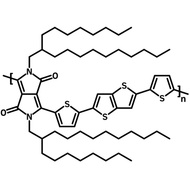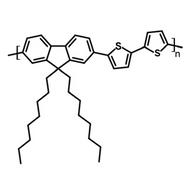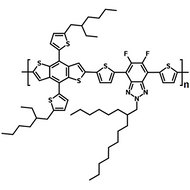What Is A Semiconductor Polymer?

Jump to: Conjugated and Semiconductor Polymers | Why Use Semiconductor Polymers? | Semiconducting Polymer Applications | LuminosynTM Polymers
Semiconductor polymers are organic compounds arranged in a conjugated system that facilitates increased electrical conductivity.
Unlike inorganic semiconductors, where electrons move freely through extended delocalized bands, charge transport in semiconducting polymers occurs as electrons hop between localized molecular orbitals. Semiconductor polymers use alternating single and double bonds to create this conjugated system. Long chains of repeating monomer units allow electrons to move along the polymer backbone, enhancing intrachain charge transport.
This localized mechanism makes it difficult for any polymer to compete with inorganic semiconductors. However, semiconducting polymers have some benefits over other semiconductors: they are have easier production routes than inorganics, as well as the potential to be thinner, lightweight and compatible with flexible substrates. They also have the potential to be biocompatible. Semiconducting polymers could open up a whole new world for electronics, from biosensors to semi-transparent solar cells, to rolls and rolls of flexible displays.
What is a Semiconductor or Conjugated Polymer?
Semiconducting polymers contain sp²-hybridized carbons, where three electrons are occupied in sigma bonds, leaving one electron in the pz orbital. These pz orbitals occupy regions above and below the planar sigma bonded structure. Overlap of these pz orbitals forms weaker π-bonds, where the electrons are more loosely bound.
By creating a network of π-bonds, you can create delocalized electronic states that can support the movement of electrons through the polymer. This is known as a conjugated system, where these “π electrons” belong to a group of atoms (rather than a single atom) and move freely between them.
In conjugated polymers, the backbone of a polymer often consists of alternating single and double bonds. This creates different lobes of pz orbitals showing bonding (like-charge) and antibonding (opposite-charge) interactions.
As the conjugation length increases, the energy gap between the HOMO and LUMO levels decreases, which makes charge transfer easier and improves the semiconducting behavior.
Examples of Semiconducting Molecules
Why Use Semiconducting Polymers?
Semiconductor polymers offer several advantages over other materials like silicon. Some of these benefits include:
Popular Semiconducting Materials
Browse more semiconducting polymers
Semiconducting Polymer Applications
Semiconducting polymers can be incredibly useful in many different types of device.
Charge Transport Layers
Semiconductor polymers are commonly used in thin film solar cells as electron or hole transport layers. PTAA has been regularly used in perovskite solar cells and organic photovoltaics as a hole transport layer. Other examples of transport materials using semiconductor polymers include PolyTPD and PFN-Br
Organic Solar Cells
The tunable properties, high absorption and high material availability of semiconductor polymers makes them attractive prospects for use in solar cells. P3HT has been classically used in OPVs since their introduction. New polymers like PM6 is used as the p-type semiconductor and can be combined with small molecules like Y6 to create organic solar cells approaching 20% efficiency.
Organic Light Emitting Diodes
Semiconducting polymers emit strong photoluminescence and can be easily modified to produce different colors. This makes them great for use in light emitting diodes. OLEDs offer many benefits over other displays including wide viewing angles and the potential for flexible and thin screens. Polymers that are suitable for use in LED devices include F8BT, F8 and MEH-PPV.
Organic Field Effect Transistors
Semiconductor polymers can be used as the active layer in organic field-effect transistors (OFETs), controlling the flow of charge between source and drain electrodes. Their tunable electronic properties and solution processability allow for low-cost, flexible, and large-area transistor fabrication. Polymers like P3HT and DPP-based materials, such as DPP-DTT can be used in OFETs for applications as sensors and in flexible circuits.
LuminosynTM Polymers
Luminosyn polymers are synthesized and purified by our expert scientists at Ossila. These materials are high purity and made-to-order. Furthermore, with larger batches we can offer a more competitive price.
Washed & Purified
We use Soxhlet extraction methods in inert conditions to achieve high purity materials. Materials are washed with multiple solvents and non-solvents.
Batch Specific Info
Every order comes with batch-specific molecular weight info. Streamline your optimization processes and more transparently report your results, by knowing as much about your material as possible.
Made To Order
Order as much material as you need. Larger order quantities and higher molecular weights are possible with these materials. Ensure consistency between experiments by sourcing polymers from one large batch.
Popular LuminosynTM Products Include
Browse more LuminosynTM polymers
Learn More
 Organic Field Effect Transistors (OFET)
Organic Field Effect Transistors (OFET)
An organic field effect transistor (OFET) is a device that uses a small gate voltage to control the current flow across an organic semiconductor material. This type of organic thin film transistor (OTFT) serves as an alternative to silicon-based field effect transistors such as MOSFETs. OFET devices consist of drain and source electrodes, a dielectric layer, an organic semiconductor (OSC) and a voltage electrode.
Read more...Organic semiconductors are materials, ranging from small molecules to polymers, that can transport charge. Unlike conducting materials, where electrons move freely across the material, organic semiconductors rely on a structure primarily composed of carbon and hydrogen atoms. These atoms are arranged to enable overlap of π-orbitals, allowing electron delocalization within each molecule.
Read more...References
Huseynova, G., Hyun Kim, Y., Lee, J.-H., & Lee, J. (2019). Rising advancements in the application of PEDOT:PSS as a prosperous transparent and flexible electrode material for solution-processed organic electronics. Journal of Information Display, 21(2), 71–91. https://doi.org/10.1080/15980316.2019.1707311
Wang, Z., & Liu, R. (2023). PEDOT:PSS-based electrochromic materials for flexible and stretchable devices. Materials Today Electronics, 4, 100036. https://doi.org/10.1016/j.mtelec.2023.100036
Contributors
Written by
Application Scientist
Diagrams by
Graphic Designer


















